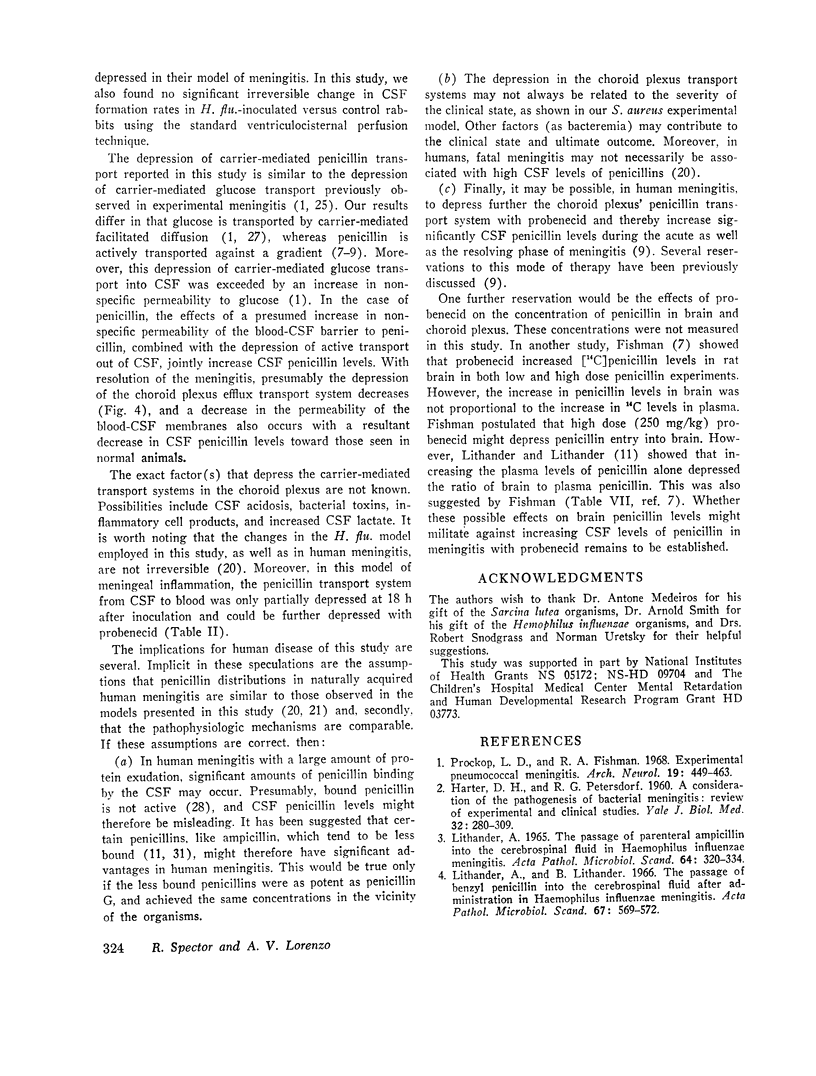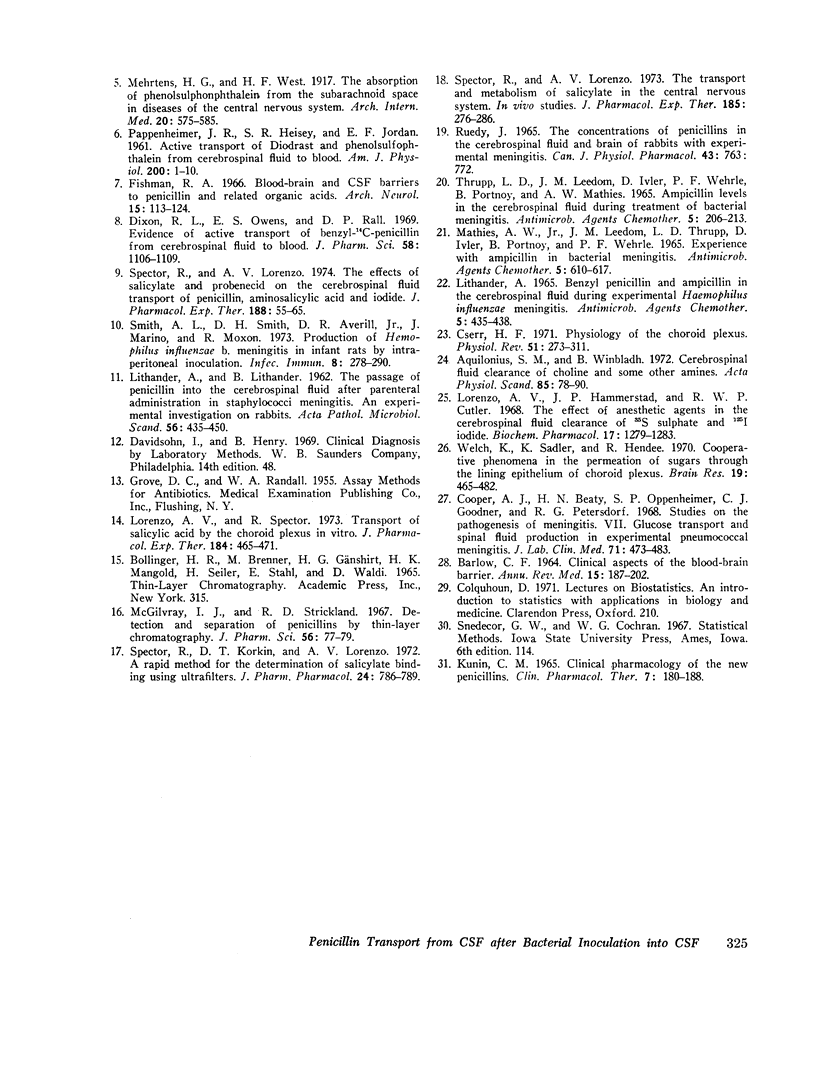Abstract
The effect of intracisternal inoculation of bacteria on the choroid plexus system, which transports penicillin from cerebrospinal fluid (CSF) to blood, was studied in vitro and in vivo. Meningeal and choroid plexus inflammations as well as CSF pleocytosis were induced in rabbits with intracisternal inoculations of Hemophilus influenzae or Staphylococcus aureus. At various times after bacterial inoculation, the choroid plexuses of the inoculated rabbits were removed and incubated in artificial CSF containing [14C]penicillin. The ability of the choroid plexuses to accumulate pencillin in vitro was measured and was found to be depressed as compared with controls. This depression of choroid plexus uptake reversed with resolution of the inflammatory process. In vivo on the day after intracisternal inoculation of Hemophilus influenzae, a decrease in the disappearance of penicillin relative to inulin in the inoculated rabbits (as compared to the controls) was observed when [14C]penicillin and [3H]inulin were injected intraventricularly and cisternal CSF was sampled 2 h later. This decrease could not be explained by penicillin binding to the CSF exudate. However, the choroid plexus transport system for penicillin was only partially depressed in those inoculated rabbits with bacterially induced inflammation, since in vitro the choroid plexuses could still accumulate penicillin and in vivo CSF penicillin levels could be further increased with probenecid pretreatment. These results suggest that CSF penicillin levels are increased in this model due to three factors: a depression of active efflux of penicillin from the CSF, an increase in permeability to penicillin of inflamed meninges, and, less significantly, by CSF binding of penicillin.
Full text
PDF









Images in this article
Selected References
These references are in PubMed. This may not be the complete list of references from this article.
- Aquilonius S. M., Winbladh B. Cerebrospinal fluid clearance of choline and some other amines. Acta Physiol Scand. 1972 May;85(1):78–90. doi: 10.1111/j.1748-1716.1972.tb05237.x. [DOI] [PubMed] [Google Scholar]
- BARLOW C. F. CLINICAL ASPECTS OF THE BLOOD-BRAIN BARRIER. Annu Rev Med. 1964;15:187–202. doi: 10.1146/annurev.me.15.020164.001155. [DOI] [PubMed] [Google Scholar]
- Cooper A. J., Beaty H. N., Oppenheimer S. I., Goodner C. J., Petersdorf R. G. Studies on the pathogenesis of meningitis. VII. Glucose transport and spinal fluid production in experimental pneumococcal meningitis. J Lab Clin Med. 1968 Mar;71(3):473–483. [PubMed] [Google Scholar]
- Cserr H. F. Physiology of the choroid plexus. Physiol Rev. 1971 Apr;51(2):273–311. doi: 10.1152/physrev.1971.51.2.273. [DOI] [PubMed] [Google Scholar]
- Dixon R. L., Owens E. S., Rall D. P. Evidence of active transport of benzyl-14C-penicillin from cerebrospinal fluid to blood. J Pharm Sci. 1969 Sep;58(9):1106–1109. doi: 10.1002/jps.2600580914. [DOI] [PubMed] [Google Scholar]
- Fishman R. A. Blood-brain and CSF barriers to penicillin and related organic acids. Arch Neurol. 1966 Aug;15(2):113–124. doi: 10.1001/archneur.1966.00470140003001. [DOI] [PubMed] [Google Scholar]
- HARTER D. H., PETERSDORF R. G. A consideration of the pathogenesis of bacterial meningitis: review of experimental and clinical studies. Yale J Biol Med. 1960 Feb;32:280–309. [PMC free article] [PubMed] [Google Scholar]
- Kunin C. M. Clinical pharmacology of the new penicillins. II. Effect of drugs which interfere with binding to serum proteins. Clin Pharmacol Ther. 1966 Mar-Apr;7(2):180–188. doi: 10.1002/cpt196672180. [DOI] [PubMed] [Google Scholar]
- LITHANDER A., LITHANDER B. The passage of penicillin into the cerebrospinal fluid after parenteral administration in staphylococcic meningitis. 1. An experimental investigation on rabbits. Acta Pathol Microbiol Scand. 1962;56:435–450. doi: 10.1111/j.1699-0463.1962.tb04196.x. [DOI] [PubMed] [Google Scholar]
- Lithander A. Benzyl penicillin and ampicillin in the cerebrospinal fluid during experimental Haemophilus influenzae meningitis. Antimicrob Agents Chemother (Bethesda) 1965;5:435–438. doi: 10.1128/AAC.5.5.435. [DOI] [PubMed] [Google Scholar]
- Lithander A., Lithander B. The passage of benzyl penicillin into the cerebrospinal fluid after administration in Haemophilus influenzae meningitis. An experimental investigation in rabbits. Acta Pathol Microbiol Scand. 1966;67(4):569–572. doi: 10.1111/apm.1966.67.4.569. [DOI] [PubMed] [Google Scholar]
- Lithander A. The passage of parenteral ampicillin into the cerebrospinal fluid in Haemophilus influenzae meningitis. An experimental investigatiion in rabbits. Acta Pathol Microbiol Scand. 1965;64(3):329–334. doi: 10.1111/apm.1965.64.3.329. [DOI] [PubMed] [Google Scholar]
- Lorenzo A. V., Hammerstad J. P., Cutler R. W. The effect of anaesthetic agents on the cerebrospinal fluid clearance of 35S-sulphate and 125-I-iodide. Biochem Pharmacol. 1968 Jul;17(7):1279–1283. doi: 10.1016/0006-2952(68)90065-8. [DOI] [PubMed] [Google Scholar]
- Lorenzo A. V., Spector R. Transport of salicylic acid by the choroid plexus in vitro. J Pharmacol Exp Ther. 1973 Feb;184(2):465–471. [PubMed] [Google Scholar]
- Mathies A. W., Jr, Leedom J. M., Thrupp L. D., Ivler D., Portnoy B., Wehrle P. F. Experience with ampicillin in bacterial meningitis. Antimicrob Agents Chemother (Bethesda) 1965;5:610–617. [PubMed] [Google Scholar]
- McGilveray I. J., Strickland R. D. Detection and separation of penicillins by thin-layer chromatography. J Pharm Sci. 1967 Jan;56(1):77–79. doi: 10.1002/jps.2600560116. [DOI] [PubMed] [Google Scholar]
- PAPPENHEIMER J. R., HEISEY S. R., JORDAN E. F. Active transport of Diodrast and phenolsulfonphthalein from cerebrospinal fluid to blood. Am J Physiol. 1961 Jan;200:1–10. doi: 10.1152/ajplegacy.1961.200.1.1. [DOI] [PubMed] [Google Scholar]
- Prockop L. D., Fishman R. A. Experimental pneumococcal meningitis. Permeability changes influencing the concentration of sugars and macromolecules in cerebrospinal fluid. Arch Neurol. 1968 Nov;19(5):449–463. doi: 10.1001/archneur.1968.00480050019001. [DOI] [PubMed] [Google Scholar]
- Smith A. L., Smith D. H., Averill D. R., Jr, Marino J., Moxon E. R. Production of Haemophilus influenzae b meningitis in infant rats by intraperitoneal inoculation. Infect Immun. 1973 Aug;8(2):278–290. doi: 10.1128/iai.8.2.278-290.1973. [DOI] [PMC free article] [PubMed] [Google Scholar]
- Spector R., Korkin D. T., Lorenzo A. V. A rapid method for the determination of salicylate binding by the use of ultrafilters. J Pharm Pharmacol. 1972 Oct;24(10):786–789. doi: 10.1111/j.2042-7158.1972.tb08883.x. [DOI] [PubMed] [Google Scholar]
- Spector R., Lorenzo A. V. The effects of salicylate and probenecid on the cerebrospinal fluid transport of penicillin, aminosalicyclic acid and iodide. J Pharmacol Exp Ther. 1974 Jan;188(1):55–65. [PubMed] [Google Scholar]
- Spector R., Lorenzo A. V. The transport and metabolism of salicylate in the central nervous system: in vivo studies. J Pharmacol Exp Ther. 1973 May;185(2):276–286. [PubMed] [Google Scholar]
- Thrupp L. D., Leedom J. M., Ivler D., Wehrle P. F., Portnoy B., Mathies A. W. Ampicillin levels in the cerebrospinal fluid during treatment of bacterial meningitis. Antimicrob Agents Chemother (Bethesda) 1965;5:206–213. [PubMed] [Google Scholar]
- Welch K., Sadler K., Hendee R. Cooperative phenomena in the permeation of sugars through the lining epithelium of choroid plexus. Brain Res. 1970 May 4;19(3):465–482. doi: 10.1016/0006-8993(70)90389-6. [DOI] [PubMed] [Google Scholar]






